

The game Gala derives from medieval times, and perhaps goes as far back as the Viking age. The four great corner fields, which are separated by lines, symbolize castles. The lines are the walls, or mounds, of the castles. These put some restrictions on the movement of the pieces. The following rules description builds predominantly on Arnold Mayer's reconstruction.
Game goals
• to capture both of the enemy Galas (kings). Alternatively, it's sufficient to capture one of the Galas (preferable).
• to move both Galas to the four central squares. (there is also a variant where lone Gala loses)
Certain wins are regarded as finer:
• Great victory: a player has placed both Galas in the centre.
• Minor victory: a player has placed one of his Galas in the centre and eliminated both enemy Galas.
Draw occurs when both players have one Gala in the "holy centre", and there are no more Galas on the board.
The pieces
Pieces capture by entering a square which is occupied by an enemy piece. For the Kampas and the Horsas there are some restrictions in capturing while crossing a mound line (see below). Pieces may not cross two mound lines in one move. The centre, consisting of four squares, is an "holy site", and only the Galas and the Kampas are able to enter there. The Kampas can only enter if the centre is already occupied by a Gala, or by an enemy Kampa.
Kampa ('warrior') initially moves one step diagonally towards the centre. After being promoted the Kampa can move and capture one step in all directions. But the Kampa is not allowed to enter the inner part of the friendly castles, because this area is reserved for the higher classes. Two Gala variants are presented here. They differ only in Kampa promotion: (1) promotion occurs after the first move (2) promotion occurs after passing the line to the cross. In variant (1), should the Kampa return to any of the initial squares of the friendly Kampas, its movement capability is again restricted to the initial movement. In variant (2), should it return to any of the friendly castles its movement capability is again restricted to the initial movement (excepting the square diagonally adjacent to the centre). When passing the line, inwards or outwards, the Kampa cannot capture.
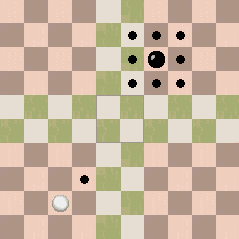 The Kampa moves diagonally toward the centre when positioned at its start position. Otherwise it moves like a king in chess. It can enter the centre squares.
The Kampa moves diagonally toward the centre when positioned at its start position. Otherwise it moves like a king in chess. It can enter the centre squares.
Korna ('berserk warrior') moves orthogonally outside the cross. Moves diagonally inside. Can make an additional move after crossing the line. If the Korna crosses the line with the first square he moves, he may move, in addition, any number of free squares diagonally. Otherwise, when crossing the line, his optional additional move is only one square diagonally. If capture occurs when crossing the line, there is no additional move.
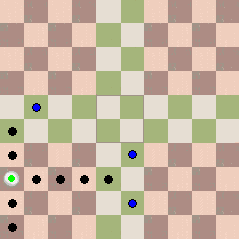 The Korna moves orthogonally outside the cross, diagonally inside. The blue dots represent the additional bonus move due to crossing the line. In this case the Korna is placed more than one step outside the cross, hence it can only move one additional step inside the cross. Otherwise it would be capable of continuing along the diagonal north-east. It cannot enter the centre squares.
The Korna moves orthogonally outside the cross, diagonally inside. The blue dots represent the additional bonus move due to crossing the line. In this case the Korna is placed more than one step outside the cross, hence it can only move one additional step inside the cross. Otherwise it would be capable of continuing along the diagonal north-east. It cannot enter the centre squares.
Horsa ('horseman', or 'mounted warrior') moves diagonally outside the cross. Moves orthogonally inside. Can make an additional move after crossing the line. If the Horsa crosses the line with the first square he moves, he may move, in addition, any number of free squares orthogonally. Otherwise, when crossing the line, his optional additional move is only one square orthogonally. If capture occurs when crossing the line, there is no additional move. Note! In its first move the Horsa can only move one step (a rule introduced by me, necessary to avoid monotonic openings).
Note: when crossing the line inwards, the Horsa is not allowed to capture an adjacent piece to the sides (i.e. any piece which is positioned alongside the line which is passed over). The Horsa (the mounted lancer), when jumping over the mound, needs space to be able to turn his horse, catch up speed, and continue the attack. There is an additional variant ("strong Horsas"), where the Horsa is still allowed to capture a piece to the side if it's aligned with the movement direction. In both cases the Horsa can capture an adjacent piece which is orthogonally "forward".
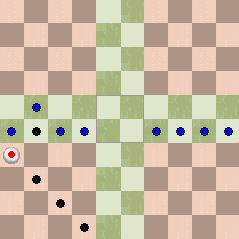 The Horsa moves diagonally outside the cross, orthogonally inside. The blue dots represent the additional bonus move due to crossing the line. In this case the Horsa is placed only one step outside the cross, hence it is allowed to move continually inside the cross. It cannot enter the centre squares, which is apparent in the image.
The Horsa moves diagonally outside the cross, orthogonally inside. The blue dots represent the additional bonus move due to crossing the line. In this case the Horsa is placed only one step outside the cross, hence it is allowed to move continually inside the cross. It cannot enter the centre squares, which is apparent in the image.
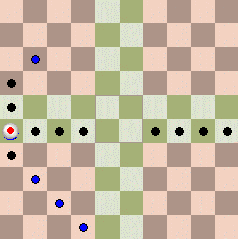 When positioned inside the cross the Horsa moves orthogonally (the opposite is true of the Korna). The blue dots represent the additional bonus move due to crossing the line. In this case the Horsa is placed beside the line at the south-western quadrant, hence it is allowed to move continually in the quadrant below. However, in the opposite quadrant, it is only allowed to move one square diagonally while being farther away from the line.
When positioned inside the cross the Horsa moves orthogonally (the opposite is true of the Korna). The blue dots represent the additional bonus move due to crossing the line. In this case the Horsa is placed beside the line at the south-western quadrant, hence it is allowed to move continually in the quadrant below. However, in the opposite quadrant, it is only allowed to move one square diagonally while being farther away from the line.
Gala ('king') can move a single step in any direction. The Gala loses the ability to capture when positioned inside the centre. (There is also a variant, "weak Galas", where the Gala is not allowed to capture when entering the centre.) From inside the centre, it can move directly to any empty square, other than the initial positions of the pieces.
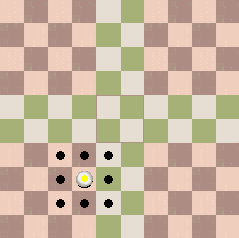 The Gala moves one step in all directions. But when inside the four centre squares it can jump immediately to any empty square except the initial squares of the pieces.
The Gala moves one step in all directions. But when inside the four centre squares it can jump immediately to any empty square except the initial squares of the pieces.
Discussion
This game, deriving from medieval times, seems to have been restricted to a small area of Schleswig-Holstein, once Denmark but now part of Germany. It appears not to be derived from chess. Nigel Pennick (Games of the Gods, 1988) says that "Gala appears to be a game which had origins separate from Chess, perhaps in early medieval European magic…" (p.220).
Personally, I would like to point out that there are significant similarities between Gala and the Viking game Tablut (Hnefatafl), and this is the reason why I chose to designate it as a Viking game. It has a kinship with the games of the Viking age, even if it probably appeared later. Gala has the "holy" central square, as in Tablut (Hnefatafl), where no other pieces than the king can enter. Like in Tablut, reaching absolute squares with the king is enough for a win. It has no leaping pieces, unlike chess and shatranj, which have both knight and alfil (elephant). Moreover, Hnefatafl and Tablut boards also often have that fourfold partition, i.e., a cross. In Tablut and Hnefatafl certain squares modify the capturing capability of the pieces. This is so also in Gala, but unknown in traditional chess. The Gala game also derives from an area close to former Viking country.
Only the Gala kings are bigger than the other pieces, all of which are of identical size and distinguished by coloured paint. Gala kings have gold tops, whereas the Kornas have green tops, the Horsas red tops, and the Kampas are identified only by the basic colour, black or white.
Gala has a clear symbolic character. The fact that the movement capabilities change depending on position rhymes with reality. A horseman (Horsa) is of less use inside the castle than outside in the open field (the central cross) where his powers grow stronger. The opposite is true of the berserk warrior (Korna) as he can cause greater damage inside a castle than outside.
Pennick says that "[t]he game of Gala is one of the most sophisticated of all board games, equalling, if not surpassing Chess in the complexity and subtlety of its possibilities" (p.217).
References
Bell, R.C. The Boardgame Book
Botermans, J. and van Delft, P. The World of Games
Glonnegger, E. Das Spiele Buch
Mayer, A. 'Gala Bauernschach' (Sagaheim-Spieleverlag)
Pennick, N. The Games of the Gods
See also chessvariants.com: Gala
You can download my free Gala program here, (updated 2009-10-01) but you must own the software Zillions of Games to be able to run it.
© M. Winther (July 2006).